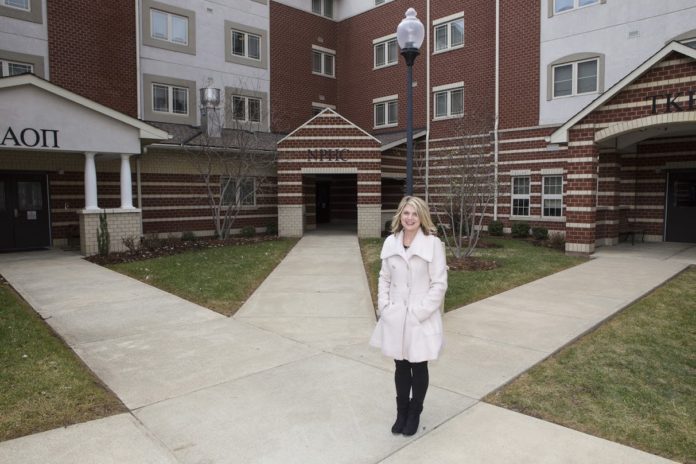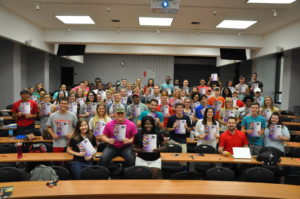
Did you know that alcohol misuse is the fifth leading risk factor for premature death and disability globally and among people between the ages of 15 and 49, it is the first? For those 20 to 39 years old, approximately 25 percent of the total deaths are alcohol attributable.
A group at UofL is working to ensure our students don’t fall victim to these statistics. The Building Resiliency in Campus Community (BRICC) Coalition, a Campus Health Services partnership, was created in 2007 in an effort to advance policies, programs and resources that increase resiliency and reduce high risk drinking on campus and in the community.
In 2010, Heather Parrino came on board as program manager. BRICC has since secured major gifts from Beam Suntory and Brown-Forman to support staff, programming, and infrastructure. They have developed additional resources, including the Voice of Reason manual and other initiatives that Parrino says have yielded tremendous success.
“We’ve been very successful because we have so many committed volunteers (about 200), we work with community and campus partners and we have external funding. I think we’re also serving as leaders in this area because we meet students where they are,” Parrino said.
That means, for example, hosting meetings in the basement of a fraternity house or sharing relevant information on residence hall bulletin boards.
Parrino specifically measures success through three metrics:
- UofL’s AlcoholEdu (alcohol prevention) and Haven (sexual violence prevention) programs, funded by the president, provost, and Campus Health Services. (AlcoholEdu is mandated for every first time freshmen and transfer student under 21 and Haven is required for every student. AlcoholEdu educates students about the impact of alcohol and how to prevent high-risk situations where alcohol is present. Haven addresses critical issues of sexual assault, relationship violence, stalking, and sexual harassment.
- A state law (KRS 244 Medical Amnesty) passed in 2013 to provide immunity from prosecution for students who choose to call for help in an emergency.
“We support students that choose to drink and students that choose not to drink. We want to make sure all of our students stay safe,” she said.
- UofL developed the Voice of Reason manual about three years ago so that students could have tangible takeaways from their prevention training programs. The manual was created after an in-depth needs assessment, in partnership with Pacific Institute for Research and Evaluation, was completed in 2010, which included a focus groups of students and staff throughout campus.
“We rode in police cars, we came to campus at night, we went into apartment complexes. We would talk to anyone who would talk to us. In our needs assessment, we realized there is a lot of misinformation out there about alcohol use and that much of the communication is ineffective and disingenuous,” Parrino said. “This was our base for the Voice of Reason manual.”
Much of BRICC’s current strategic plan also came out of the needs assessment. The main objective is to “build resilience.”
“Alcohol isn’t the number one issue, resilience is,” Parrino said. “There are two main reasons people drink – to celebrate and to deal with stress. If we can teach students how to celebrate differently – going to dinner with their friends, going on a hike, etc. – then we can teach them life skills development to avoid major issues. We can teach them resilience. At the end of the day, the stress and the reason for celebrating are still there.”
BRICC has been using the Voice of Reason manual for three years. It has been so effective, Parrino said, the University of Kentucky is piloting it this year.
BRICC also features a number of other programs, including:
- TIPs Training. TIPs stands for Training for Intervention Procedures. TIPs University certification is beneficial for students who are in charge of planning events, serving as RAs, risk management chairs and in other leadership positions. TIPs University “recognizes that students are in the best position to address drinking behaviors among their peers,” or, as Parrino explains, “meeting students where they are.”

BRICC offers monthly TIPs University certifications to students and campus/community partners that serve students. The classes last four hours. In BRICC’s fall semester training, 68 RAs were certified prior to campus move-in day.
“My favorite part as a TIPs trainer is watching people arrive thinking they are going to listen to a boring lecture about alcohol information. Our participants become very engaged as they realize they are the experts and we are going to work together to facilitate conversations to address issues that are specific to them and their friends,” Parrino said.
- BRICC Wall. The BRICC Wall interactive exhibit engages students with community members, businesses and city officials to “make changes in their communities and remove roadblocks to their academic success.” The exhibit challenges assumptions and encourages healthy decisions. It is made up of messages from students sharing their own stories about alcohol and substance abuse. The messages are written on “bricks” displayed as part of the exhibit.
- Greeks Advocating Matuer Management of Alcohol (GAMMA). BRICC provides funding, resources, and a staff advisor for Greeks Advocating Mature Management of Alcohol, a UofL RSO. In the fall, GAMMA members lead the Voice of Reason initiative, a strategy to help both drinkers and nondrinkers make safer decisions in social settings. VOR includes five one-hour sessions that cover basic alcohol knowledge, awareness of risks, effective messaging and implementing strategies.
- This semester, BRICC will also launch a new RSO called “Advocates for Recovery.” The first meeting is March 9. The organization will offer broad-based support to students in recovery, and will also include friends and allies of students in recovery. Programming will focus on increasing resilience, academic achievement, health and overall wellbeing.
Though the organization is still in the planning phase, Parrino said more than 150 students have expressed interest.
“As with everything we’ve done, we need to start from the ground and we need to find allies,” Parrino said. “I look at what we’re doing as more macro than programming. Our students need more than programming. We are constantly looking at how we can take care of them.”
More information about the BRICC Coalition is available online.





























